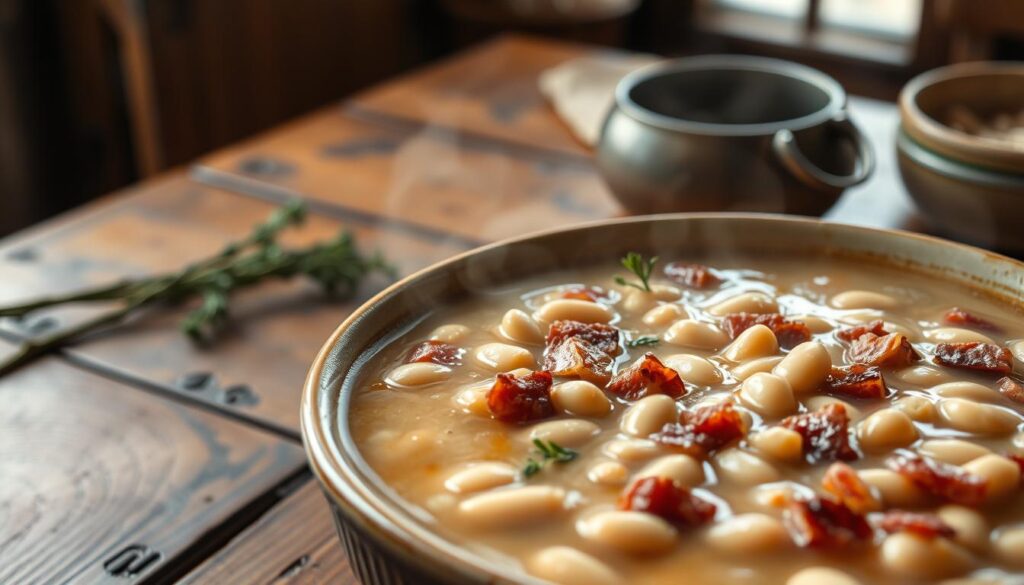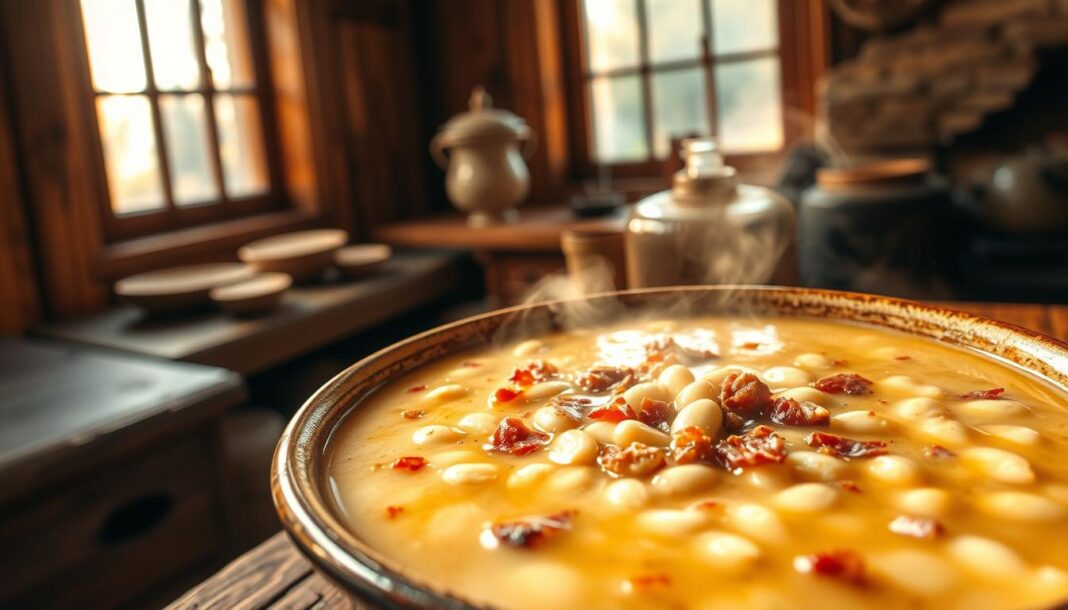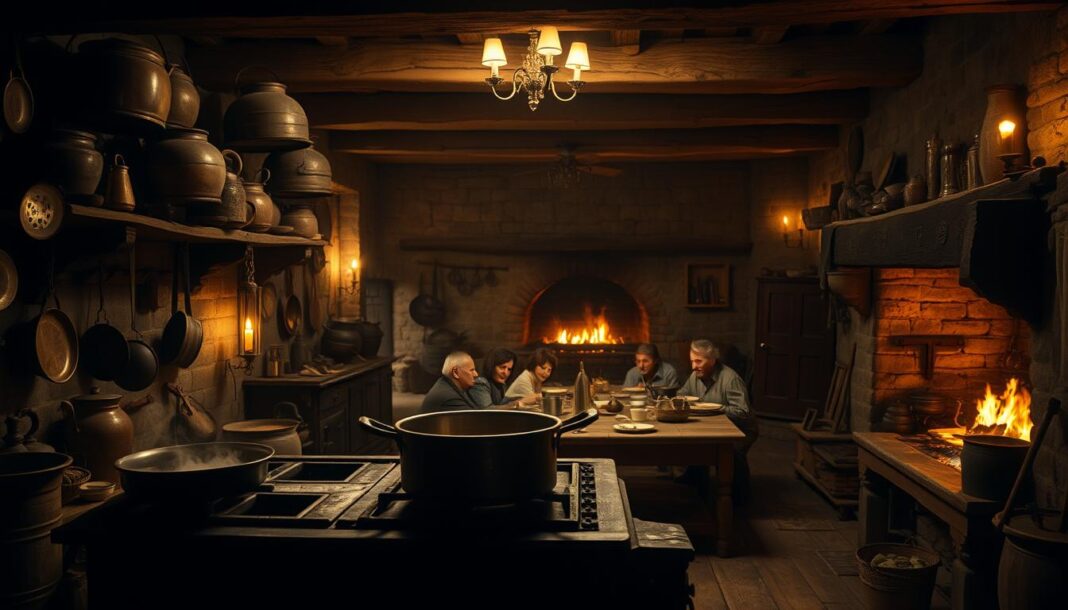We cherish the rich culinary heritage of combining white beans and bacon in various dishes that have delighted palates across Europe and America. The union of creamy beans and savory bacon creates a truly satisfying culinary experience, offering a perfect balance of simplicity and flavor complexity.
At Historical Foods, we’ve tested and refined these recipes to ensure they deliver consistent, delicious results while honoring their historical roots. From traditional soups to hearty stews, these dishes represent comfort food staples that continue to appeal to both novice and experienced cooks.
Key Takeaways
- Explore the delicious world of white bean and bacon combinations.
- Understand the nutritional benefits of combining protein-rich beans with bacon.
- Discover traditional and modern variations of white bean and bacon recipes.
- Learn why these recipes have remained popular throughout history.
- Find out how to recreate these comfort food staples in your own kitchen.
The Rich History of White Bean and Bacon Dishes
For centuries, beans have been a staple in European cuisine, often paired with cured meats like bacon to create nourishing meals. The history of white bean and bacon recipes is deeply rooted in traditional European cooking, where simplicity and practicality were key.

Traditional Origins in European Cuisine
Bean soups have deep roots in European cuisine, particularly in countries like France, Italy, and Spain, where beans were a staple food for centuries. The combination of beans with cured pork products was born out of necessity and practicality – using preserved meats to flavor nutritious, filling soup dishes. We can trace the origins of white bean and bacon dishes back to their European roots, examining how these recipes emerged from peasant cooking traditions.
The historical significance of beans as a protein-rich staple food will be explored, highlighting how they became essential to rural diets throughout Europe. Bacon and other cured pork products were traditionally used to flavor beans, creating hearty, nutritious meals that could sustain workers through long days.
Evolution of Bean Soups in American Cooking
As European settlers crossed the Atlantic, they brought their culinary traditions with them, including bean soup recipes. These dishes evolved and became integrated into American cooking traditions, particularly in New England and the Southern United States, where distinct approaches to soup emerged. For more on the evolution of soups, visit our page on medieval soup recipes.
The influence of seasonal cooking and preservation methods on these recipes will be discussed, showing how they were adapted to make use of available ingredients throughout the time. Over time, these dishes transformed from necessity-based cooking to beloved comfort foods that have endured through generations, often simmered in a rich broth.
Classic White Bean and Bacon Soup Recipe
With its hearty ingredients and rich flavors, our classic white bean and bacon soup recipe is perfect for cold winter nights or any occasion. This comforting soup combines the simplicity of white beans and bacon with a depth of flavor achieved through careful preparation and ingredient selection.
Essential Ingredients
To create our classic white bean and bacon soup, you’ll need 1 pound of dry Great Northern white beans, soaked overnight, and 5 ounces of bacon cut into pieces. Additional ingredients include 1 large onion, chopped, 2 ribs of celery, chopped, 1 large carrot, chopped, and 3 cloves of garlic, minced. You’ll also need 6 cups of chicken stock, 2 bay leaves, fresh thyme, salt, pepper, and tomato paste. The quality of these ingredients is crucial for the final flavor profile.
- Great Northern or cannellini beans are recommended for their creamy texture.
- Bacon adds a smoky depth to the soup.
- Aromatic vegetables like onion, celery, and carrot form the flavor base.
Step-by-Step Preparation
Start by cooking the bacon in a large pot over medium heat until crispy. Remove the bacon, leaving the fat, and sauté the chopped onion, celery, and carrot until tender. Add garlic and cook for 1 minute. Then, add the soaked white beans, chicken stock, bay leaves, thyme, salt, and pepper. Bring to a boil, then reduce heat and simmer for about 1 hour, or until the beans are tender. Use an immersion blender to partially puree the soup, creating a creamy base while retaining some texture.
The Secret of the Parmesan Rind
Adding a Parmesan rind during the simmering process infuses the soup with a deep umami richness and subtle creaminess. The Parmesan rind releases its savory compounds into the broth, enhancing the overall flavor profile of the soup.
Delicious White Bean and Bacon Variations
The classic white bean and bacon soup recipe can be elevated with creative variations. We explore three distinctive versions that offer unique flavor profiles while maintaining the core elements that make these dishes so satisfying.
Smoky Maple Bacon Version
The smoky maple bacon variation adds a subtle sweetness to the soup. To achieve this, you can use maple smoked bacon or cook regular thick-cut bacon with a tablespoon of maple syrup. This twist complements the savory elements and adds complexity to the overall flavor profile.
Ham Hock and Red Pepper Enhancement
The ham hock and red pepper enhancement uses a ham hock for deep savory flavor, along with diced red pepper for color and sweetness. This version also includes onion, carrots, celery, and garlic sautéed in rendered bacon fat, creating layers of flavor. The result is a more robust and complex soup.
Hearty White Bean and Bacon Stew
Transforming the basic soup into a more substantial meal, the hearty white bean and bacon stew variation adjusts the consistency and adds additional vegetables. This version is perfect for a comforting bowl on a chilly day. The key is to simmer the stew long enough to meld the flavors together.
These variations demonstrate how white bean and bacon recipes can be customized based on seasonal ingredients and personal preferences, encouraging creative adaptations in the kitchen.
Pro Tips for Perfect White Bean and Bacon Dishes
Mastering white bean and bacon dishes requires attention to detail and a few expert techniques. To create truly exceptional meals, we need to focus on three key areas: preparing the beans, balancing flavors and textures, and properly storing and reheating the final product.
Bean Preparation Techniques
Proper bean preparation is crucial for achieving the perfect texture. We can either soak white beans overnight or use a quick-soak method by bringing them to a boil, removing from heat, and letting them sit for an hour before draining. For a quicker alternative, canned beans can be used, but adjust cooking time and liquid ratios accordingly. Factors like water hardness and acidity can affect cooking time and bean texture, so it’s essential to monitor and adjust.
Balancing Flavors and Textures
Balancing flavors in white bean and bacon dishes requires caution with salt, as both bacon and stock contribute saltiness. Taste throughout the cooking process and adjust seasoning at the end. Achieving the perfect texture balance between creamy and chunky elements can be done through partial pureeing. Layering flavors throughout the cooking process is also crucial for a complex final result.
Storage and Reheating Recommendations
These soups improve with time, making them ideal for meal prep. They can be refrigerated for up to 5 days or frozen for up to 3 months. When reheating, adjust seasoning as needed and consider adding a bit of water or stock if the soup has thickened. For an example of a well-crafted white bean and bacon recipe, check out this White Bean and Bacon Soup recipe.
| Storage Method | Duration | Reheating Tips |
|---|---|---|
| Refrigeration | Up to 5 days | Add a bit of water or stock if thickened |
| Freezing | Up to 3 months | Reheat gently, adjusting seasoning as needed |
Why White Bean and Bacon Recipes Stand the Test of Time
Despite changing food trends, white bean and bacon dishes remain a beloved comfort food, offering a rich nutritional profile and satisfying taste. A typical serving provides approximately 449 calories, with 15.7g of fat, 44.5g of carbs, 10.6g of fiber, and 35.7g of protein. These dishes are high in fiber (42.4% daily value) and protein (71.4% daily value), making them a nutritious choice.
The combination of beans and bacon creates a satisfying meal that offers substantial nutrition while delivering comfort food appeal. With their impressive nutritional credentials and delicious flavor, it’s no wonder these recipes have stood the test of time, providing an excellent balance of protein, fiber, and complex carbohydrates in a typical soup or stew.


